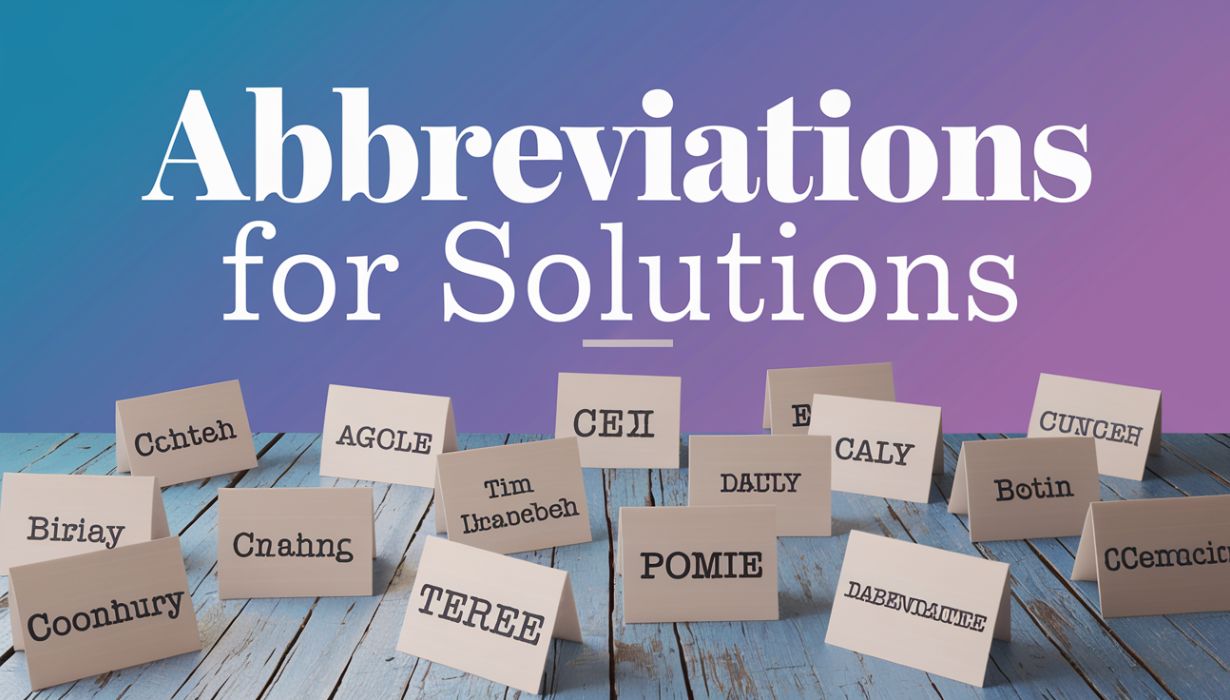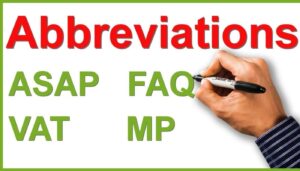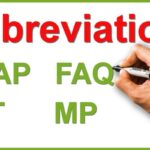In today’s fast-paced world, communication is everything. We want to convey ideas, solve problems, and share solutions as quickly and efficiently as possible. Whether you’re drafting an email, creating a report, or engaging in a casual conversation, abbreviations are often your best friend. But when it comes to the abbreviation for “solutions,” you might be wondering: Is there a widely accepted short form, or does it depend on context?
In this article, we’ll explore the abbreviation for “solutions,” how and when to use it, as well as some helpful tips for improving your communication with abbreviations. Let’s dive into how abbreviations can help streamline your language and make your message clear and concise, all while ensuring you’re using them appropriately.
What Is the Abbreviation for “Solutions”?
Before jumping into examples and contexts, let’s first address the most straightforward question: What is the abbreviation for “solutions?”
The most commonly used abbreviation for “solutions” is “Sols.”
It’s a simple, easy-to-remember abbreviation that can be used in a variety of contexts, from business to casual exchanges. However, the use of “Sols” can vary depending on the industry, region, or even personal preference. While “Sols” is widely recognized, it’s always essential to assess your audience to ensure they will understand the abbreviation you’re using.
Why Abbreviate “Solutions”?
There are several reasons why people use abbreviations like “Sols.” Here are a few:
- Space and Time Saving: Abbreviations save precious space in documents and messages. This is particularly useful in technical writing, presentations, or when you’re working with limited character counts, such as on social media.
- Enhanced Readability: Long, complex terms can sometimes disrupt the flow of your writing. Using abbreviations can make your communication more fluid and readable, especially in lists, charts, or infographics.
- Professional Context: In some professional settings, using abbreviations or acronyms is a way to signal expertise or familiarity with industry-specific language. It’s a shorthand that professionals use to convey ideas quickly and effectively.
- Informal Communication: For informal exchanges—think text messages, emails, or casual conversations—abbreviations help you get to the point faster, keeping things light and easy.
Abbreviation in Different Contexts
Now that we have a basic understanding of “Sols,” let’s explore where and when it’s appropriate to use this abbreviation. It’s important to note that the context will influence whether “Sols” is the best choice or whether an alternative is more appropriate.
1. Business and Corporate Settings
In the business world, clarity and efficiency are crucial. Abbreviations like “Sols” are common in reports, presentations, and proposals. When discussing products, services, or solutions offered by a company, you might see “Sols” used in headlines or sections.
For instance:
- Product Sols: A product catalog may include a section titled “Product Sols” where different products and their respective solutions are outlined.
- Client Sols: In a report, you might see the term “client Sols” to describe the solutions provided to a specific client.
It’s important to note that while “Sols” is often understood in business contexts, there could be situations where the abbreviation may seem too informal or out of place, especially in formal reports or legal documents. If in doubt, it’s better to write out the word “solutions.”
2. Technical Writing and Manuals
In technical writing, precision and clarity are paramount. While “Sols” might be common in some fields, other technical documents may require more specific terms. For example, if you’re working in software development or engineering, “solutions” might not always be reduced to “Sols” because different types of solutions (technical, software, operational) might need their full descriptions to avoid confusion.
Example:
- Technical Sols: A manual for a software product might list “Technical Sols” to describe the available fixes or patches.
3. Marketing and Advertising
Marketing often thrives on catchy language and brevity. Abbreviations can make your messages punchy and easy to digest, especially in digital formats like websites, emails, or social media. In some cases, marketers may prefer an alternative abbreviation like “Sol.” However, “Sols” is still more universally accepted and understood.
Example:
- Business Sols for Startups: A marketing campaign targeting startups might advertise “Affordable Sols” to convey cost-effective solutions.
4. Academic and Educational Writing
In academic contexts, the use of abbreviations like “Sols” may be less frequent, especially when writing papers, essays, or dissertations. It’s generally a good rule of thumb to avoid abbreviations unless they are universally accepted or specifically defined earlier in your document. If you choose to use “Sols,” make sure it’s introduced properly.
For instance:
- Various Solutions (Sols): In an academic paper, you may introduce the abbreviation “Sols” when referencing multiple approaches or problem-solving techniques. Then, use “Sols” consistently throughout the rest of the document.
5. Casual Communication
In more relaxed or informal settings, like texting or chatting with friends, abbreviations are typically more accepted. Here, “Sols” might come in handy when you’re discussing problems and their solutions casually. If you’re talking about an issue and a quick fix, referring to it as a “Sol” or “Sols” can keep the conversation light and efficient.
Example:
- Tech Sols: If a friend is struggling with a tech issue, you might offer some “tech Sols” as quick fixes or solutions.
Alternatives to “Sols”
While “Sols” is the most widely recognized abbreviation for “solutions,” there are some alternatives, depending on the situation or industry.
1. “Sol” (Singular)
In certain contexts, you might use “Sol” instead of “Sols,” especially when referring to one specific solution. The abbreviation “Sol” is more concise and could work well in cases where you’re addressing individual solutions rather than multiple options.
Example:
- “We have the Sol for your issue!” (Here, “Sol” refers to one specific solution.)
2. “S.”
Another alternative, though less common, is simply using the letter “S.” However, this abbreviation is much less specific and can easily lead to confusion if it’s not clear what the “S” refers to.
Example:
- “This S. is easy to implement.”
While this is occasionally used in more technical fields, it’s generally advisable to stick with “Sols” to avoid ambiguity.
Tips for Using Abbreviations Effectively
Using abbreviations, including “Sols,” can be an excellent tool for efficient communication, but it’s important to do so thoughtfully. Here are some tips to ensure that your use of abbreviations remains clear and professional:

1. Know Your Audience
Always consider who will be reading or receiving your message. Abbreviations like “Sols” might be well understood in a business environment but could confuse someone unfamiliar with your industry. When in doubt, write the full word “solutions” the first time you mention it, and then use the abbreviation afterward.
2. Use Abbreviations Sparingly
While abbreviations can be handy, they should not clutter your writing. Don’t overload your message with too many abbreviations, as this can hinder readability. Stick to the most relevant abbreviations and only use them where they add value.
3. Provide Context
If you decide to use abbreviations, make sure you provide context. This could mean briefly explaining the term the first time it appears in your document or conversation.
For example:
- “We offer various solutions (Sols) for every business need.”
4. Avoid Over-Using Abbreviations in Formal Writing
In formal or academic writing, it’s often best to avoid abbreviations entirely unless they are widely accepted or defined early in the document. It ensures clarity and maintains the formality of your writing.
5. Consistency Is Key
Once you introduce an abbreviation like “Sols,” make sure to use it consistently throughout the piece. Switching between “Sols” and “solutions” might confuse the reader. So, be sure to stick to one throughout your text.
Final Words
Using abbreviations like “Sols” for “solutions” can save time and space, making communication more efficient and direct. However, it’s essential to use them appropriately based on your audience, context, and the formality of the situation.
By understanding when and where to use abbreviations, you can ensure that your message remains clear, professional, and easy to digest.
Remember, while abbreviations like “Sols” can be incredibly useful, they should always be used with caution. Know your audience, avoid overuse, and ensure that your communication is as clear and effective as possible.









